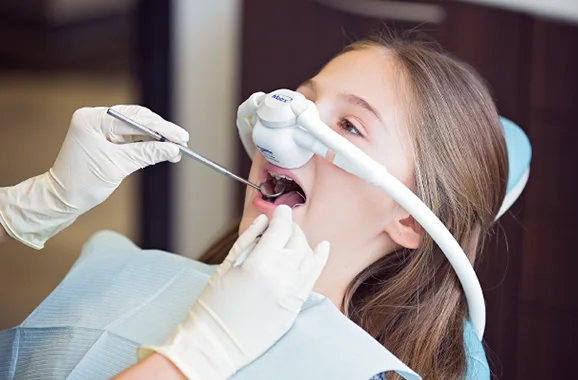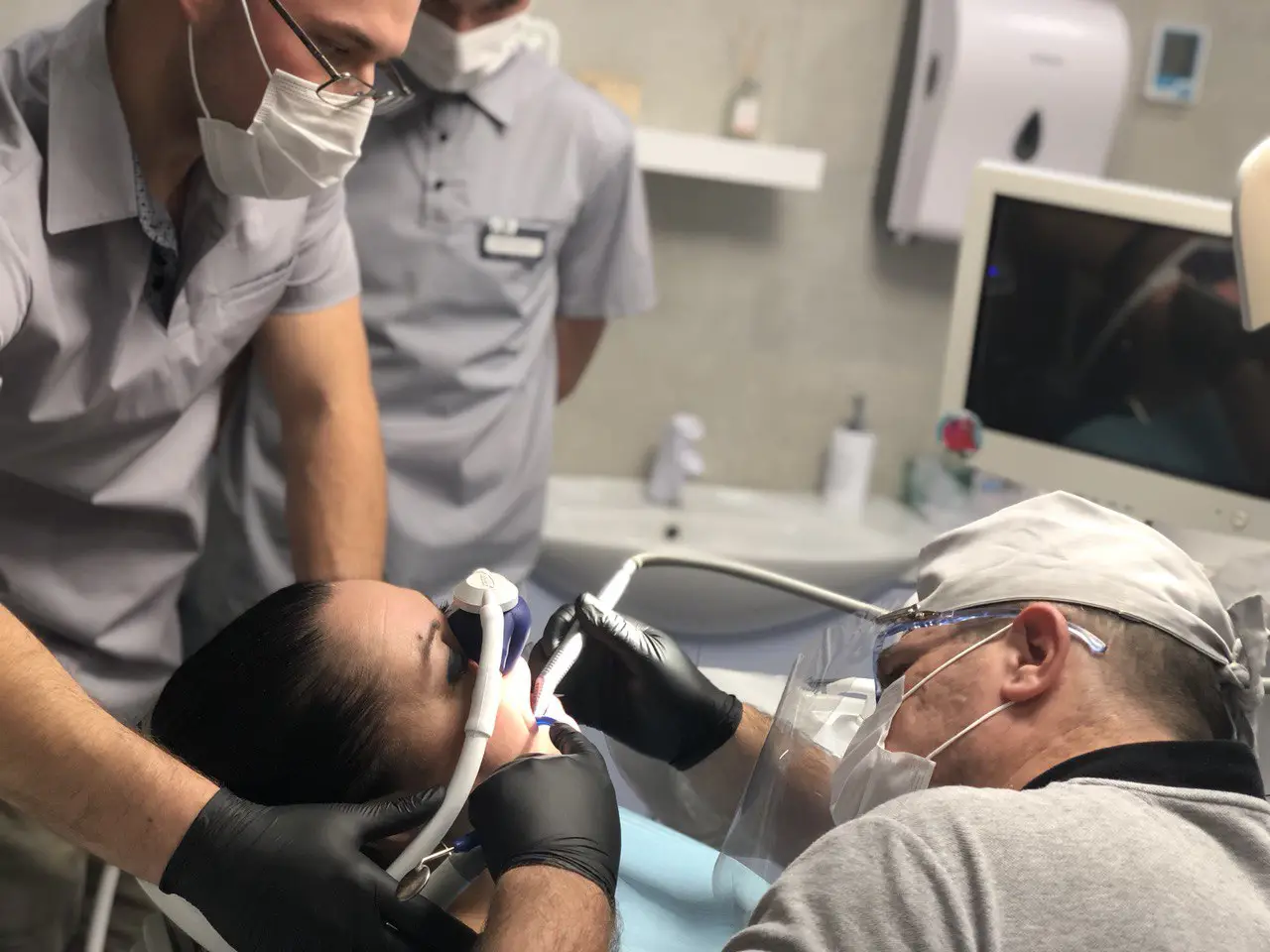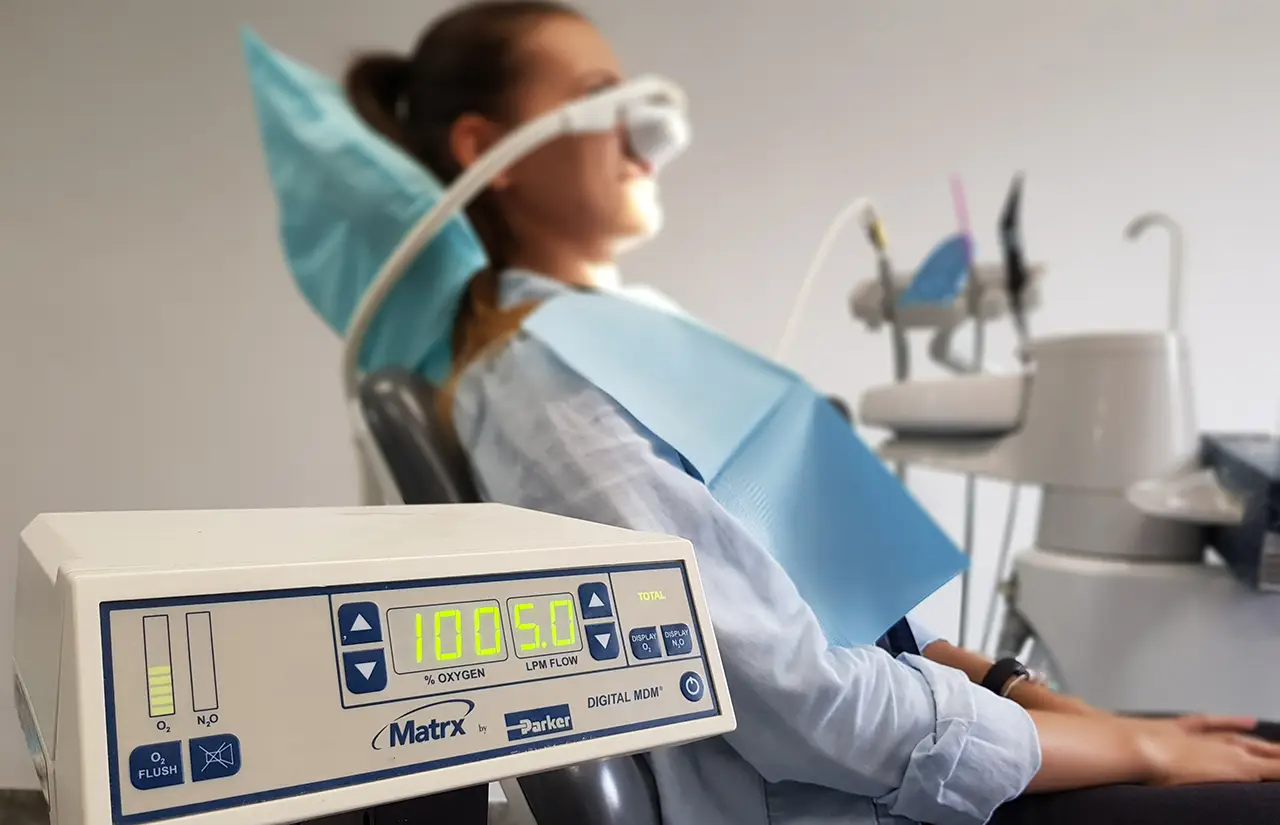Nitrous oxide is a modern solution to fears in dentistry

Every person experiences a slight anxiety when visiting the dentist. However, for many children and adults, it is very difficult to overcome the fear of treatment. Anxiety and fear interfere with the work of the dentist and often make it impossible. If the mention of dentistry causes you significant discomfort or keeps you from visiting the doctor altogether, it is important to seek a solution.
Modern dentistry is designed to make all procedures as painless as possible for patients. Due to the high prevalence of odontophobia (fear of visiting the dentist and dental treatment), dentists around the world have started thinking about how to help patients. This is how nitrous oxide entered dental practice. This method has been successfully practiced around the world for decades. Originally created for comfortable treatment of children, it has transitioned into adult practice, becoming highly popular in most clinics across Europe and America.
If you haven’t heard about dental treatment using the oxygen mixture or nitrous oxide, you’ll be pleasantly surprised, as now, taking care of your healthy smile will be associated only with positive emotions.
We focus not only on the quality of treatment but also on your comfort. If you have had a negative dental experience and as a result, refuse to take care of your health, contact “Sigma Dent”. Our doctors will treat your concern respectfully, listen carefully, and suggest the optimal sedation technique.
Patients often ask: What is nitrous oxide? Does its effect resemble general anesthesia? Is it safe to have dental treatment while “asleep”? What are the indications for this method? Are there any contraindications?
Let’s take a closer look!
Nitrous oxide, also known as “laughing gas”, or NOX (nitrous oxide – oxygen mixture), is an inert gas with a barely perceptible sweet odor that, when combined with oxygen, provides a harmless sedation for the patient (treatment in peace). The gas contains ozone, which we love to inhale after a thunderstorm. This substance occurs when oxygen (O2) turns into O3 due to the effect of static electricity. The mixture itself consists of 78% nitrogen, 21% oxygen, and a small amount of other inert gases. These safe compounds are successfully used in modern dentistry to ensure that both children and adults feel comfortable.

What is the difference between anesthesia and sedation?
Anesthesia is general pain relief, with complete or partial loss of consciousness and sensitivity. When you wear the nitrous oxide mask, you remain conscious (surface sedation). This type of sedation is drastically different from general anesthesia or sleep treatment. The gas itself does not have a pain-relieving effect. However, local anesthesia (numbing) administered under its effect is perceived much more comfortably and less painfully. Additionally, due to the calming effect of nitrous oxide, the level of adrenaline in the patient’s blood is reduced, allowing for a smaller amount of anesthetic to be used during the procedure.
At Sigma Dent, we use the modern Matrx system from Parker, which ensures safety, ease of use, and reliability necessary for the delivery of nitrous oxide, providing a sedative effect that helps create a stress-free environment, promoting comfort for the patient and convenience for the doctor.

This method is suitable for both children and adults who feel anxiety about dental treatment, vulnerable individuals who do not want unpleasant memories of visiting the doctor, patients with a strong gag reflex, as well as for dental implants and other various dental procedures. Nitrous oxide sedation also allows for complex treatments, such as treating pulpitis, with subsequent restoration using composite materials or standard crowns in one visit.
For tooth extraction, this sedation also works very well. The effect produced by the “laughing gas” is enough to make the patient feel comfortable in a completely relaxed state. This relaxation of the chewing muscles allows the dentist to remove the tooth faster and more efficiently, as there is less resistance and tension from the patient. Additionally, swelling of the tissues is less common, which reduces the frequency of antibiotic prescriptions, easing rehabilitation after difficult extractions.
What are the indications for the procedure?
- Preschool children who need local anesthesia.
- Children and adults with a negative dental experience in the past.
- Children with hyperactivity syndrome. Nitrous oxide sedation doubles the child’s ability to sit still.
- Patients requiring lengthy treatments (complex extractions, pulpitis treatment, implantation, etc.), large volumes of dental manipulations, which may cause discomfort (including psychological) to the patient (e.g., removal of wisdom teeth, surgical treatment of cysts, implant procedures, etc.).
- Low pain threshold. However, NOX in no way excludes the use of local anesthesia, it only enhances its effect.
- Severe fear of dental procedures.
- Enhancing the effect of local anesthesia and improving pain control (reducing the required amount of anesthetic for effective pain relief).
- Strong gag reflex.
What are the contraindications for the procedure?
- Under the age of 3 years.
- The child may simply refuse to wear the breathing mask, and the effect of sedation could be unpredictable.
- Children with severe anxiety. It is not uncommon for a child to experience panic fear before treatment, and the state of the oral cavity may not support prolonged adaptation of the child.
- A large volume of dental intervention in young children. Small patients get tired from frequent visits, and by the 4th-5th visit, they may refuse to wear the nasal mask and continue treatment.
- Difficulty breathing through the nose, runny nose, adenoiditis, and other respiratory diseases (i.e., airway diseases). Since the oxygen-nitrous mixture is delivered via a nasal mask, the child must breathe freely through the nose.
- Children with epilepsy, Down syndrome, or autism. For them, an alternative treatment method is sleep treatment.
How is the procedure performed at Sigma Dent?
Nitrous oxide is delivered through a special mask, which is placed on the patient’s nose, ensuring no disruption to breathing, and the patient remains conscious, in a relaxed state, losing sensitivity and experiencing complete calm. Nitrous oxide works by calming the body and removing unpleasant sensations. Then, the specialist performs all necessary procedures.
The specialist determines the dosage of the substance for each patient individually and can adjust it during the treatment. When mixed with oxygen, both gases are maintained at a safe level for the body. After treatment, within 5-10 minutes, the patient fully returns to their usual state. Dental treatment with nitrous oxide is safe for health, does not cause addiction, and has no side effects.
How will I feel during the procedure?
Before starting treatment, a mask is placed on the patient, delivering pure oxygen. Soon, nitrous oxide is added to it and adjusted to the most suitable concentration for you. The effect takes hold within minutes. Patients report a feeling of relaxation, mild disorientation, and slight intoxication during the procedure. There may be a slight tingling sensation in the arms and legs, indicating the calming effect has begun. You remain almost fully conscious (in a semi-sleep state) and can communicate. The intensity of the sedative effect can be regulated during the procedure.
After completing the procedure, the doctor reduces the concentration of nitrous oxide, and you return to your usual state. For a short time, you may feel a slight dizziness. The transition out of the sedation state occurs gradually and ends with the inhalation of 100% oxygen for 5-10 minutes.
Is nitrous oxide safe during treatment of children?
The use of NOX greatly facilitates the treatment process for both the child and the pediatric dentist. Children develop a positive attitude toward dental visits and a culture of dental health.

